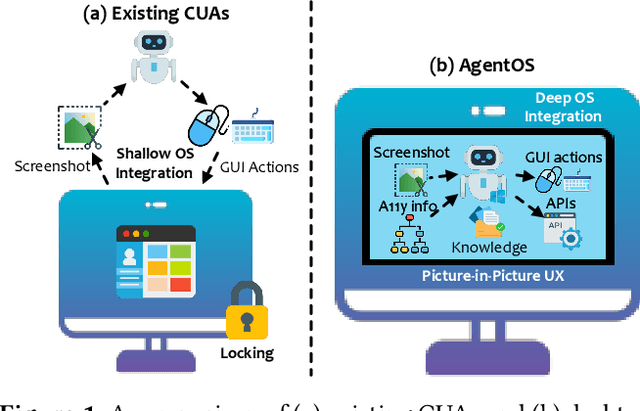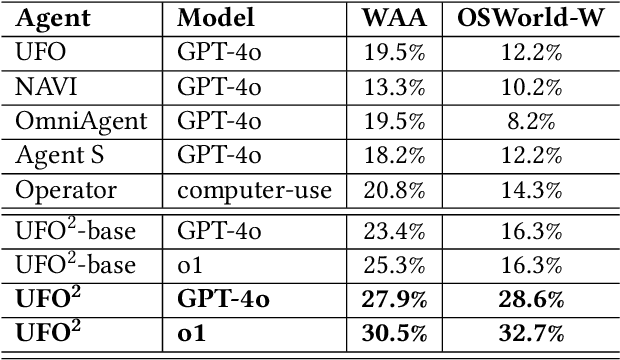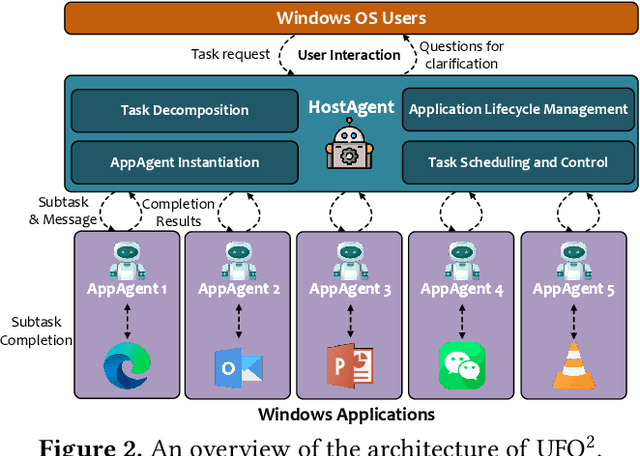Yu Kang
GUI-360: A Comprehensive Dataset and Benchmark for Computer-Using Agents
Nov 06, 2025Abstract:We introduce GUI-360$^\circ$, a large-scale, comprehensive dataset and benchmark suite designed to advance computer-using agents (CUAs). CUAs present unique challenges and is constrained by three persistent gaps: a scarcity of real-world CUA tasks, the lack of automated collection-and-annotation pipelines for multi-modal trajectories, and the absence of a unified benchmark that jointly evaluates GUI grounding, screen parsing, and action prediction. GUI-360$^\circ$ addresses these gaps with an LLM-augmented, largely automated pipeline for query sourcing, environment-template construction, task instantiation, batched execution, and LLM-driven quality filtering. The released corpus contains over 1.2M executed action steps across thousands of trajectories in popular Windows office applications, and includes full-resolution screenshots, accessibility metadata when available, instantiated goals, intermediate reasoning traces, and both successful and failed action trajectories. The dataset supports three canonical tasks, GUI grounding, screen parsing, and action prediction, and a hybrid GUI+API action space that reflects modern agent designs. Benchmarking state-of-the-art vision--language models on GUI-360$^\circ$ reveals substantial out-of-the-box shortcomings in grounding and action prediction; supervised fine-tuning and reinforcement learning yield significant gains but do not close the gap to human-level reliability. We release GUI-360$^\circ$ and accompanying code to facilitate reproducible research and accelerate progress on robust desktop CUAs. The full dataset has been made public on https://huggingface.co/datasets/vyokky/GUI-360.
Context and Diversity Matter: The Emergence of In-Context Learning in World Models
Sep 26, 2025Abstract:The capability of predicting environmental dynamics underpins both biological neural systems and general embodied AI in adapting to their surroundings. Yet prevailing approaches rest on static world models that falter when confronted with novel or rare configurations. We investigate in-context environment learning (ICEL), shifting attention from zero-shot performance to the growth and asymptotic limits of the world model. Our contributions are three-fold: (1) we formalize in-context learning of a world model and identify two core mechanisms: environment recognition and environment learning; (2) we derive error upper-bounds for both mechanisms that expose how the mechanisms emerge; and (3) we empirically confirm that distinct ICL mechanisms exist in the world model, and we further investigate how data distribution and model architecture affect ICL in a manner consistent with theory. These findings demonstrate the potential of self-adapting world models and highlight the key factors behind the emergence of ICEL, most notably the necessity of long context and diverse environments.
C3RL: Rethinking the Combination of Channel-independence and Channel-mixing from Representation Learning
Jul 23, 2025Abstract:Multivariate time series forecasting has drawn increasing attention due to its practical importance. Existing approaches typically adopt either channel-mixing (CM) or channel-independence (CI) strategies. CM strategy can capture inter-variable dependencies but fails to discern variable-specific temporal patterns. CI strategy improves this aspect but fails to fully exploit cross-variable dependencies like CM. Hybrid strategies based on feature fusion offer limited generalization and interpretability. To address these issues, we propose C3RL, a novel representation learning framework that jointly models both CM and CI strategies. Motivated by contrastive learning in computer vision, C3RL treats the inputs of the two strategies as transposed views and builds a siamese network architecture: one strategy serves as the backbone, while the other complements it. By jointly optimizing contrastive and prediction losses with adaptive weighting, C3RL balances representation and forecasting performance. Extensive experiments on seven models show that C3RL boosts the best-case performance rate to 81.4\% for models based on CI strategy and to 76.3\% for models based on CM strategy, demonstrating strong generalization and effectiveness. The code will be available once the paper is accepted.
Graph Neural Networks in Modern AI-aided Drug Discovery
Jun 07, 2025Abstract:Graph neural networks (GNNs), as topology/structure-aware models within deep learning, have emerged as powerful tools for AI-aided drug discovery (AIDD). By directly operating on molecular graphs, GNNs offer an intuitive and expressive framework for learning the complex topological and geometric features of drug-like molecules, cementing their role in modern molecular modeling. This review provides a comprehensive overview of the methodological foundations and representative applications of GNNs in drug discovery, spanning tasks such as molecular property prediction, virtual screening, molecular generation, biomedical knowledge graph construction, and synthesis planning. Particular attention is given to recent methodological advances, including geometric GNNs, interpretable models, uncertainty quantification, scalable graph architectures, and graph generative frameworks. We also discuss how these models integrate with modern deep learning approaches, such as self-supervised learning, multi-task learning, meta-learning and pre-training. Throughout this review, we highlight the practical challenges and methodological bottlenecks encountered when applying GNNs to real-world drug discovery pipelines, and conclude with a discussion on future directions.
SWE-bench Goes Live!
May 29, 2025Abstract:The issue-resolving task, where a model generates patches to fix real-world bugs, has emerged as a critical benchmark for evaluating the capabilities of large language models (LLMs). While SWE-bench and its variants have become standard in this domain, they suffer from key limitations: they have not been updated since their initial releases, cover a narrow set of repositories, and depend heavily on manual effort for instance construction and environment setup. These factors hinder scalability and introduce risks of overfitting and data contamination. In this work, we present \textbf{SWE-bench-Live}, a \textit{live-updatable} benchmark designed to overcome these challenges. Our initial release consists of 1,319 tasks derived from real GitHub issues created since 2024, spanning 93 repositories. Each task is accompanied by a dedicated Docker image to ensure reproducible execution. Central to our benchmark is \method, an automated curation pipeline that streamlines the entire process from instance creation to environment setup, removing manual bottlenecks and enabling scalability and continuous updates. We evaluate a range of state-of-the-art agent frameworks and LLMs on SWE-bench-Live, revealing a substantial performance gap compared to static benchmarks like SWE-bench, even under controlled evaluation conditions. To better understand this discrepancy, we perform detailed analyses across repository origin, issue recency, and task difficulty. By providing a fresh, diverse, and executable benchmark grounded in live repository activity, SWE-bench-Live facilitates rigorous, contamination-resistant evaluation of LLMs and agents in dynamic, real-world software development settings.
Learning Multi-view Multi-class Anomaly Detection
Apr 30, 2025Abstract:The latest trend in anomaly detection is to train a unified model instead of training a separate model for each category. However, existing multi-class anomaly detection (MCAD) models perform poorly in multi-view scenarios because they often fail to effectively model the relationships and complementary information among different views. In this paper, we introduce a Multi-View Multi-Class Anomaly Detection model (MVMCAD), which integrates information from multiple views to accurately identify anomalies. Specifically, we propose a semi-frozen encoder, where a pre-encoder prior enhancement mechanism is added before the frozen encoder, enabling stable cross-view feature modeling and efficient adaptation for improved anomaly detection. Furthermore, we propose an Anomaly Amplification Module (AAM) that models global token interactions and suppresses normal regions to enhance anomaly signals, leading to improved detection performance in multi-view settings. Finally, we propose a Cross-Feature Loss that aligns shallow encoder features with deep decoder features and vice versa, enhancing the model's sensitivity to anomalies at different semantic levels under multi-view scenarios. Extensive experiments on the Real-IAD dataset for multi-view multi-class anomaly detection validate the effectiveness of our approach, achieving state-of-the-art performance of 91.0/88.6/82.1 and 99.1/43.9/48.2/95.2 for image-level and the pixel-level, respectively.
Zoomer: Adaptive Image Focus Optimization for Black-box MLLM
Apr 30, 2025



Abstract:Recent advancements in multimodal large language models (MLLMs) have broadened the scope of vision-language tasks, excelling in applications like image captioning and interactive question-answering. However, these models struggle with accurately processing visual data, particularly in tasks requiring precise object recognition and fine visual details. Stringent token limits often result in the omission of critical information, hampering performance. To address these limitations, we introduce \SysName, a novel visual prompting mechanism designed to enhance MLLM performance while preserving essential visual details within token limits. \SysName features three key innovations: a prompt-aware strategy that dynamically highlights relevant image regions, a spatial-preserving orchestration schema that maintains object integrity, and a budget-aware prompting method that balances global context with crucial visual details. Comprehensive evaluations across multiple datasets demonstrate that \SysName consistently outperforms baseline methods, achieving up to a $26.9\%$ improvement in accuracy while significantly reducing token consumption.
Reservoir-enhanced Segment Anything Model for Subsurface Diagnosis
Apr 26, 2025Abstract:Urban roads and infrastructure, vital to city operations, face growing threats from subsurface anomalies like cracks and cavities. Ground Penetrating Radar (GPR) effectively visualizes underground conditions employing electromagnetic (EM) waves; however, accurate anomaly detection via GPR remains challenging due to limited labeled data, varying subsurface conditions, and indistinct target boundaries. Although visually image-like, GPR data fundamentally represent EM waves, with variations within and between waves critical for identifying anomalies. Addressing these, we propose the Reservoir-enhanced Segment Anything Model (Res-SAM), an innovative framework exploiting both visual discernibility and wave-changing properties of GPR data. Res-SAM initially identifies apparent candidate anomaly regions given minimal prompts, and further refines them by analyzing anomaly-induced changing information within and between EM waves in local GPR data, enabling precise and complete anomaly region extraction and category determination. Real-world experiments demonstrate that Res-SAM achieves high detection accuracy (>85%) and outperforms state-of-the-art. Notably, Res-SAM requires only minimal accessible non-target data, avoids intensive training, and incorporates simple human interaction to enhance reliability. Our research provides a scalable, resource-efficient solution for rapid subsurface anomaly detection across diverse environments, improving urban safety monitoring while reducing manual effort and computational cost.
UFO2: The Desktop AgentOS
Apr 20, 2025



Abstract:Recent Computer-Using Agents (CUAs), powered by multimodal large language models (LLMs), offer a promising direction for automating complex desktop workflows through natural language. However, most existing CUAs remain conceptual prototypes, hindered by shallow OS integration, fragile screenshot-based interaction, and disruptive execution. We present UFO2, a multiagent AgentOS for Windows desktops that elevates CUAs into practical, system-level automation. UFO2 features a centralized HostAgent for task decomposition and coordination, alongside a collection of application-specialized AppAgent equipped with native APIs, domain-specific knowledge, and a unified GUI--API action layer. This architecture enables robust task execution while preserving modularity and extensibility. A hybrid control detection pipeline fuses Windows UI Automation (UIA) with vision-based parsing to support diverse interface styles. Runtime efficiency is further enhanced through speculative multi-action planning, reducing per-step LLM overhead. Finally, a Picture-in-Picture (PiP) interface enables automation within an isolated virtual desktop, allowing agents and users to operate concurrently without interference. We evaluate UFO2 across over 20 real-world Windows applications, demonstrating substantial improvements in robustness and execution accuracy over prior CUAs. Our results show that deep OS integration unlocks a scalable path toward reliable, user-aligned desktop automation.
Large Language Model Compression via the Nested Activation-Aware Decomposition
Mar 21, 2025Abstract:In this paper, we tackle the critical challenge of compressing large language models (LLMs) to facilitate their practical deployment and broader adoption. We introduce a novel post-training compression paradigm that focuses on low-rank decomposition of LLM weights. Our analysis identifies two main challenges in this task: the variability in LLM activation distributions and handling unseen activations from different datasets and models. To address these challenges, we propose a nested activation-aware framework (NSVD) for LLMs, a training-free approach designed to enhance the accuracy of low-rank decompositions by managing activation outliers through transforming the weight matrix based on activation distribution and the original weight matrix. This method allows for the absorption of outliers into the transformed weight matrix, improving decomposition accuracy. Our comprehensive evaluation across eight datasets and six models from three distinct LLM families demonstrates the superiority of NSVD over current state-of-the-art methods, especially at medium to large compression ratios or in multilingual and multitask settings.
 Add to Chrome
Add to Chrome Add to Firefox
Add to Firefox Add to Edge
Add to Edge